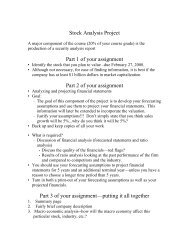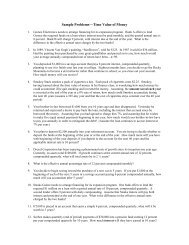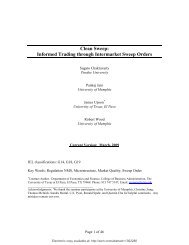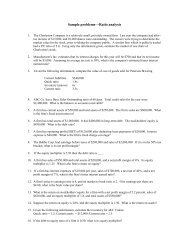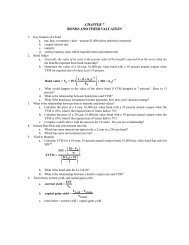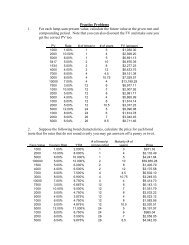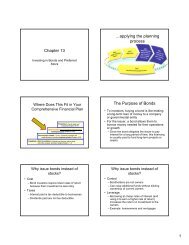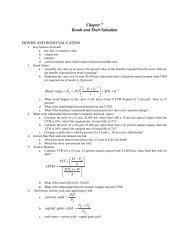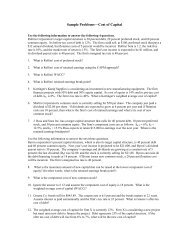BUSINESS FINANCE I FIN 331, Fall 2006
BUSINESS FINANCE I FIN 331, Fall 2006
BUSINESS FINANCE I FIN 331, Fall 2006
Create successful ePaper yourself
Turn your PDF publications into a flip-book with our unique Google optimized e-Paper software.
⎯⎯⎯⎯⎯⎯⎯⎯⎯⎯⎯⎯⎯⎯⎯⎯⎯⎯⎯⎯⎯⎯⎯⎯⎯⎯⎯⎯⎯⎯⎯⎯⎯⎯⎯⎯⎯⎯⎯⎯⎯<br />
<strong>BUSINESS</strong> <strong><strong>FIN</strong>ANCE</strong> I<br />
<strong>FIN</strong> <strong>331</strong>, <strong>Fall</strong> <strong>2006</strong><br />
⎯⎯⎯⎯⎯⎯⎯⎯⎯⎯⎯⎯⎯⎯⎯⎯⎯⎯⎯⎯⎯⎯⎯⎯⎯⎯⎯⎯⎯⎯⎯⎯⎯⎯⎯⎯⎯⎯⎯⎯⎯<br />
Dr. Bonnie Van Ness<br />
Office: 362 Holman Hall<br />
Phone: 915-6749<br />
Office hours: 2:00pm –3:00pm Tuesday and Thursday (or by appointment)<br />
Email: bvanness@bus.olemiss.edu<br />
Course Website: http://faculty.bus.olemiss.edu/bvanness<br />
⎯⎯⎯⎯⎯⎯⎯⎯⎯⎯⎯⎯⎯⎯⎯⎯⎯⎯⎯⎯⎯⎯⎯⎯⎯⎯⎯⎯⎯⎯⎯⎯⎯⎯⎯⎯⎯⎯⎯⎯⎯<br />
Goals and Objectives: This course is an introduction to business finance. It emphasizes the financing<br />
and investment decisions of the financial manager. Included are topics such as time value of money, asset<br />
valuation, risk analysis, financial statement analysis, and capital budgeting.<br />
Course Materials:<br />
The required textbook for this course is Essentials of Corporate Finance, Ross, Westerfield and Jordan<br />
© 2007 by McGraw-Hill.<br />
Strongly recommended: The Texas Instruments BAII Plus financial calculator. A financial calculator is<br />
not required for this course--the time value of money formulas will be provided on all tests. However,<br />
problem solving is much easier with a financial calculator.<br />
If you have another financial calculator that you are comfortable with, you may use it; however, I will<br />
only discuss the use of the TI BAII Plus for in-class examples.<br />
Prerequisites:<br />
Accounting 201 and 202 should have been passed prior to enrolling in this course. Also, Economics 202,<br />
Economics 203, and Business 230 with a minimum grade of C.<br />
Classroom:<br />
Lectures are designed to clarify and supplement text material. Unless otherwise instructed, you will be<br />
held responsible for all reading assignments (even if they are not covered in the lecture) plus all<br />
supplementary material.<br />
This is a problem-oriented course. I will use many numerical examples in class to illustrate the concepts.<br />
You are expected to read the relevant material and attempt the end-of-chapter problems before each class.<br />
Additional problems as well as concept questions can be found on the text’s self-study CD-ROM. It is<br />
very important that you work the relevant problems on a timely basis. Do not put off solving problems<br />
until just before the examinations --- it will be too late for you to truly understand the material.<br />
Grading:<br />
Grades will be based on four mid-semester exams, homework/quiz scores, and a cumulative final exam.<br />
The grade will calculated as follows:<br />
Exams:<br />
90% (the best 4-out-of-5 exam grades will count 22.5% each)<br />
Homework/quizzes: 10%<br />
<strong>FIN</strong> <strong>331</strong> Business Finance—<strong>Fall</strong> <strong>2006</strong>—Syllabus 1
Homework counts for 10% of your final grade. The homework is the suggested problems listed on the<br />
syllabus and is due the day the chapter is covered. That is, for Chapter 2, the homework is due Thursday,<br />
August 24 th . I DO NOT accept late homework. Homework is graded on a Pass/Fail system.<br />
The quality of classroom discussion depends heavily upon the degree of student preparation.<br />
Students who have not read the text AND attempted to work homework problems before<br />
coming to class will find this course to be more difficult.<br />
I will count the best 4 of the 5 exams. These 4 exams will count 90% of the final grade. All exams will<br />
be closed book/closed notes. Exams may have a mixture of multiple choice, fill in the blank, matching,<br />
and problem solving questions. You will be provided with a formula sheet for each exam. The formula<br />
sheet will be posted on the course website before each exam for you to review if you wish.<br />
Further, course grades are based on a modified ten-point scale, i.e, an A is assigned for a course<br />
average of 90-100, a B is assigned for a course average of 80-89, a C is assigned for a course<br />
average of 70-79, a D is assigned for a course average of 60-69, and a F is assigned for a course<br />
average of below 60. Any reduction or modification in the minimum average to receive a<br />
particular grade will be made consistently across all students (e.g. a student with an 89.3 will not<br />
be awarded an A grade and one with an 89.6 a B). Determination of the final breakpoint (if lower<br />
than 90 for an A) will be made on the basis of difficulty of tests, distribution of final averages,<br />
and natural gaps in the distribution of final averages. The same is also true for B, C and D<br />
grades.<br />
There will be no make-up exams. It is your responsibility to attend all exams at the scheduled time. The<br />
exam portion of your grade is calculated on a best 4-out-of-5 basis. If an exam is missed – whether due to<br />
an emergency, tragedy, or simply because you are unprepared – then the remaining four test scores will<br />
be used to compute your exam portion of the class grade. There are no exceptions to this policy.<br />
Using the best 4-out-of-5 test scores is equivalent to having a drop grade. You get ONLY ONE drop<br />
grade. Please exercise this option wisely.<br />
School of Business Administration - Statement of Academic Integrity:<br />
The School of Business Administration upholds honor and academic integrity in all of its teaching,<br />
research, and service activities. All business faculty, staff, and students are charged with the<br />
responsibility to behave with personal and professional integrity and to refrain from dishonorable<br />
conduct.<br />
Any student caught cheating will be assigned an F in the course. In most cases a statement will also be<br />
made to that effect in the student’s record.<br />
Notes:<br />
It is the responsibility of any student with a disability who requests a reasonable accommodation to<br />
contact the Office of Student Disability Services (915-7128). SDC will then contact the instructor<br />
through the student by means of an Instructor Notification of Classroom Accommodations form. Please<br />
complete the notification procedure within the first two weeks of the course. Please advise me in advance<br />
of any needs you may have as I CANNOT accommodate them at the last minute.<br />
Due to privacy issues, I do not e-mail grades and I do not give out grades over the telephone.<br />
<strong>FIN</strong> <strong>331</strong> Business Finance—<strong>Fall</strong> <strong>2006</strong>—Syllabus 2
You are encouraged to seek answers to your questions as they arise. The material discussed in class gets<br />
progressively more complex. Consequently, you will soon feel lost if you do not get clarification quickly.<br />
Please do not wait until the end of the semester or the day before a test to ask for help—there’s not much<br />
we can do at that time.<br />
Cell phone usage<br />
Please turn off your cell phone when in the classroom.<br />
All cell phones must be turned off and stored during exams as you will not be allowed to use the<br />
calculator on your cell phone during exams.<br />
Please see me prior to class if there is an impending emergency that waiting until the end of class will<br />
materially alter.<br />
Tentative Class Schedule for <strong>FIN</strong> <strong>331</strong><br />
<strong>Fall</strong> <strong>2006</strong><br />
August<br />
September<br />
October<br />
November<br />
December<br />
22<br />
24<br />
29<br />
31<br />
5<br />
7<br />
12<br />
14<br />
19<br />
21<br />
26<br />
28<br />
3<br />
5<br />
10<br />
12<br />
17<br />
19<br />
24<br />
26<br />
31<br />
2<br />
7<br />
9<br />
14<br />
16<br />
21<br />
23<br />
28<br />
30<br />
6<br />
T<br />
R<br />
T<br />
R<br />
T<br />
R<br />
T<br />
R<br />
T<br />
R<br />
T<br />
R<br />
T<br />
R<br />
T<br />
R<br />
T<br />
R<br />
T<br />
R<br />
T<br />
R<br />
T<br />
R<br />
T<br />
R<br />
T<br />
R<br />
T<br />
R<br />
W<br />
Introduction, Chapter 1<br />
Chapter 2 Suggested Problems: 1-5, 8-11, 15, 19-22<br />
Chapter 3 Suggested Problems: 1-13, 19-21, 24, 26-28, 31, 32, 38, 43<br />
Chapter 16 Suggested Problems: 2-7, 9-12<br />
Review<br />
Test 1<br />
Chapter 4 Suggested Problems: 1-7, 11-13, 18, 20,25<br />
Chapter 5 Suggested Problems: 1-10, 12, 13, 18-21, 24, 30, 34-40, 45, 49,50<br />
Chapter 5<br />
Chapter 6 Suggested Problems: 1-12, 17-19, 23-27<br />
Chapter 6<br />
Review<br />
Test2<br />
Chapter 7 Suggested Problems: 1-8, 10, 13-17, 23<br />
Chapter 8 Suggested Problems: 1, 3-7, 10-13, 15, 20, 22<br />
No Class<br />
Chapter 8<br />
Chapter 9 Suggested Problems: 1-6, 9-12, 14, 18-20, 24<br />
Review<br />
Test 3<br />
Chapter 10 Suggested Problems : 1-10, 20, 23<br />
Chapter 11 Suggested Problems: 1-5, 7, 9, 11-19, 22, 23, 25, 30<br />
Chapter 12 Suggested Problems: 1-6, 9-14, 17, 18, 19, 23, 25-27<br />
Chapter 17 Suggested Problems: 2-7, 10-12, 14, 16<br />
Review<br />
Test 4<br />
THANKSGIVING BREAK<br />
THANKSGIVING BREAK<br />
Review<br />
Review<br />
<strong>FIN</strong>AL noon<br />
<strong>FIN</strong> <strong>331</strong> Business Finance—<strong>Fall</strong> <strong>2006</strong>—Syllabus 3



